Twelve percent of the world’s species are considered threatened with extinction according to the IUCN Red List, the authority on such matters. While habitat destruction and alien invasive species bear the brunt of the responsibility, the commercial pet trade has contributed to the decline of some of the world’s most beautiful species.
But with several species on the brink of extinction in the wild, captive-breeding efforts have taken on new significance. Now a San Francisco Bay Area resident is working to take such efforts to a new level.
When asked where are most exotic birds born in captivity, one might assume that the answer is zoos. However, private aviculturists account for bulk of bird breeding in the U.S. While most of them breed exotic birds for the pet market, there is a small but growing movement to breed birds, especially those that are endangered, for conservation purposes. Michele Raffin is at the forefront of the new wave of bird breeders who believe that unless some of these birds are bred for conservation purposes, they will die out both in the wild and in captivity.
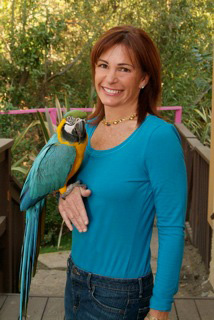 Raffin at her home |
Raffin operates Pandemonium Aviaries out of her home (“Pandemonium” refers not to the state of her home, but the term for a flock of parrots). Pandemonium’s mission is both simple and grandiose: To save all birds, one bird at a time. Her commitment is staggering: her house has more than 50 enclosures ranging in size from a half bathroom to a small house. Pandemonium has several hundred birds across 39 species, each of which is fed a special diet (much of the fruit and vegetables come from local organic markets) and carefully matched for compatibility with other species. The birds’ level of comfort is reflected by Raffin’s success in breeding several exotic tropical doves species. But these birds aren’t for re-sale — Raffin’s ambitions are even grander. She hopes to establish healthy captive populations of rare species that could someday, under the right conditions and with proper safeguards in place, be reintroduced to the wild. Furthermore, she plans to enlist the support of the few remaining exotic bird breeders to do the same: in other words, to become conservationists.
“The long-term goal of ARC (Avian Recovery for Conservation) is to prevent selected species from going extinct,” she told mongabay.com. “We are able to do this because the US imported 350,000 birds a year from the wild until the Wild Bird Act of 1992 stopped this practice. Therefore, we have a reservoir of birds that could be used to re-populate areas that no longer support these birds provided, of course, that there is protected habitat to ensure survival.”
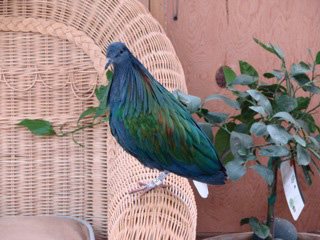 Nicobar pigeon at Pandemonium Aviaries |
But Raffin says there’s little time to waste in getting ARC up and running: “The birds and the knowledge of how to breed them is vanishing rapidly. It’s possible that we only have five years before it’s too late.”
Raffin is doing her part to ensure some knowledge lives on—she and her team of volunteers document every aspect of behavior. Some of the findings have been published in bird-keeping publications and trade journals. She is asking breeders of rare species to do this same.
In a January 2010 interview with mongabay.com’s Rhett Butler, Raffin spoke about her Pandemonium, ARC, and the exotic bird trade.
AN INTERVIEW WITH MICHELE RAFFIN
mongabay.com: What inspired you to start Pandemonium?
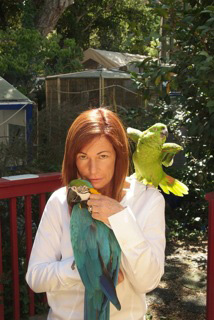 Raffin at her home |
Michele Raffin: Pandemonium came about incrementally over time. It began when I found a hurt dove by the side of the road.
At the time I was heavily involved in dog and cat rescue, although I have loved animals all of my life and have rescued a lot of different animals. I didn’t know anything about birds and in my efforts to learn about how to care for doves got introduced to a world that was new to me. I discovered the incredible talents, personalities and challenges of ensuring that birds survive in captivity. I also became painfully aware that there were not many resources to assist birds. Husbandry knowledge is not easily accessible, there are not many avian vets and in general bird care varies by species.
I was inspired, in short, by falling in love with the complexity, intelligence and personalities of birds while at the same time becoming aware of the multitude of threats to their existence and the scarcity of resources to counter these threats.
mongabay.com: So Pandemonium didn’t arise out as a hobby?
Michele Raffin: No. As a sanctuary, I primarily took in birds that I didn’t want, the rationale being that if I wanted a bird I was asked to take, the bird probably could find a home elsewhere.
I took in only the rejects: the birds that were afraid of people, or in poor health or had complicated husbandry needs. Most of them were considered “aviary” birds and not many people have aviaries. The irony is that without my realizing it, many of the birds that I took because no one else wanted them became quite rare.
mongabay.com: How large is your operation today?
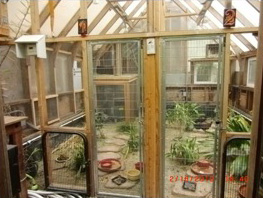 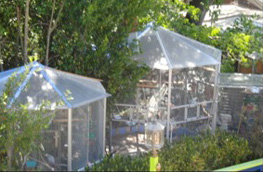 Facilities at Pandemonium Aviaries |
Michele Raffin: It’s hard to answer the size of our operation. We are probably the third largest non-companion bird sanctuary in the US, but other than that I’m not sure how to measure our size. We used to have 54 different species of birds. We have cut way back to 39. However, our numbers of individual birds has risen as we transition to breeding endangered species rather than provide sanctuary for birds that have no where else to go. We have more than 300 birds at our sanctuary and more than 50 aviaries.
mongabay.com: What are the biggest challenges of keeping so many birds from such a wide range of places?
Michele Raffin: There are husbandry challenges to keeping so many different species: we have to feed many different diets, we have to provide supplemental heat for some birds and cooling for others; there is so much to know (and so much we don’t know) plus when we mix species we have to be very, very careful that they are compatible.
mongabay.com: How do you support your operation?
Michele Raffin: We are a 501c3 non-profit. We depend on donations and the good will of our wonderful volunteers to work hard on our behalf for no financial compensation.
Our long-term goals are to save as many birds as we can. We do this by
- Ex situ breeding of endangered exotic birds that are already in the US with the goal of returning them to the wild when there is a safe “wild” for them
- By advancing avian knowledge. Everything we do that we feel is unique or not well understood we document. We necropsy every bird that dies in order to understand cause of death and if it was due to human error, we make sure this does not happen again.
- We educate by writing and giving presentations to groups.
mongabay.com: Do you do talks at schools? What are you teaching?
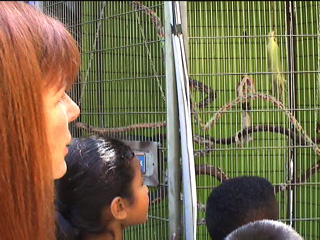 Raffin with young children from East Palo Alto looking at her birds |
Michele Raffin: We used to do education such as bringing Girl Scout troops, school groups, etc. I still sometimes host kids (18 4 and 5 year olds from East Palo Alto came over last summer.) because I’m a sucker for such things, but we are not well set up for that and the visits upset the birds. Education is mainly done through speaking to groups, writing for journals (and I’m writing a book).
As we have become more focused on conservation, the educational part of what we do has diminished. There is urgency for conservation. Can’t wait for the school children to grow up and handle it. In fact, if we wait 5 years to do the work I am doing, it will be too late. Can’t do everything myself so have to trust that others are doing education. Audubon is good at it. So are others.
mongabay.com: Do you have opinions on the exotic bird trade?
Michele Raffin: I have strong opinions about the exotic bird trade. To put it in context, here is what I believe:
- People should continue to be allowed to have pet birds. People care about what they know. To know one bird is the first step to saving all birds. To know one bird is realize that they are worth saving.
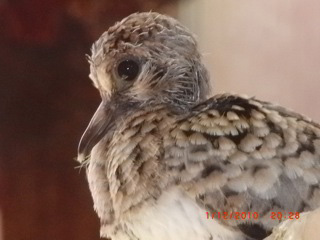
Baby Cape DoveHowever, only birds that are not endangered should be in the pet market. Endangered birds should be bred for conservation purposes only.
- Breeding birds is not bad. What is horrible is mistreatment of any animal. That should not be allowed.
- Breeders who take the position, “This is America. No one should regulate me or put regulations on me,” should realize that their best protection from regulation is to do a good job. If they are going to be in the business of raising companion animals, they have a responsibility to do it in a way that safeguards the well being of the animal. Furthermore, they have a responsibility to that animal even after it is sold. If the buyer gives up that animal, the breeder has the responsibility to make sure the animal is all right and has a home.
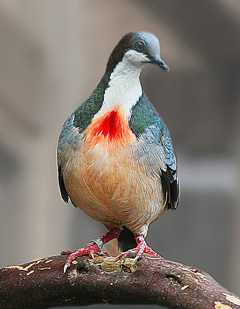
Luzon Bleeding Heart.
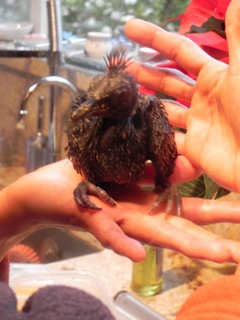
Victoria Crown pigeon hatchling. - Breeding organizations that take the position, “Our job is to stand up and protect our members no matter what” should consider the long term ramifications of not policing their own. Groups like the ASA and AFA should police their own. There is no excuse for bad breeders. The other breeders know who they are, just the way that doctors know who the bad doctors are. Other breeders should either: pitch in and help if a breeder loses control and can’t handle his animals, or intervene to shut the breeder down. I don’t think that some one who is hurting animals should be defended by their trade organization as a matter of principle. The principle that needs to be protected is that the welfare of the animal comes first.
- Zoos are in the business of displaying animals. They have not yet, for the most part, been able to fulfill their stated intentions to become conservationists. They have not done a good job breeding endangered birds for a variety of reasons. The sad thing is that many of us think that birds are going to be okay because the zoos are going to protect them. This simply isn’t the case.
There is a legitimate reason to import endangered birds that are bred in other countries (by breeders, not from the wild) in order to keep bloodlines vibrant. This is very, very difficult to do nowadays because of the laws that are in place to protect birds from the wild.
However, anyone who takes a bird out of the wild unless the bird is under mortal threat and taking it out is the way to save it should be put in prison and never let out.
What we overlook is that the wild birds in this country are being destroyed by us humans. Our government poisons 4 million birds a year. Windmills, skyscrapers, cars and the glass windows in our homes kill hundreds of million birds a year. So, every time someone gets upset at what is happening in the natural world, they should take at least one action that very day to reverse the damage that is under their control. Put up Window Alert stickers on their windows. Change building codes so tall buildings are required to use glass that birds can see. Put up a hummingbird feeder, keep it clean and change the food in it frequently, donate to a worthy non-profit that is saving the environment.
mongabay.com: Admittedly, the following is an extreme case but Sheikh Saoud Bin Mohammed Bin Ali Al-Thani was a collector of rare and endangered birds who has now become a champion for their conservation via his Al Wabra Wildlife Preservation. Have you noticed similar interest among bird keepers? Are any keepers or breeders starting to realize they can help save species that have virtually disappeared in the wild?
Michele Raffin: There are a few who are actually doing it, there a handful more who think it should be done (but who aren’t) and there are few too many that are either so overwhelmed with work (breeding birds is a time consuming and not particularly lucrative vocation) or unwilling to move from an entrenched position of “I” (as in “my” birds) to ours. The saddest illustration of this is those instances where one breeder has 1 or 2 males and another has females and neither will give up “their” birds so that breeding pairs could be formed.
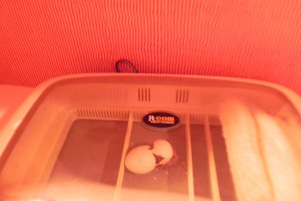 Victoria Crown pigeon egg hatching. 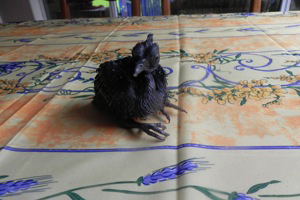 Victoria Crown pigeon hatchling. |
The reason that Pandemonium developed our ARC program was in the recognition that many breeders (for a variety of reasons) were not yet motivated to become conservationists. We would need to enlist their participation.
I applaud Sheikh Saoud Bin Mohammed Bin Ali Al-Thani for all of his conservation work, but in particular for his efforts on behalf of the Green-naped pheasant pigeon. When I first started to raise these birds for conservation purposes, the information he published on his breeding of this species was about the only guide I could find. It has been a dream of mine to visit his aviaries. While I understand that he is a bit controversial for his role in saving the Spix macaw, I consider him a hero. The bottom line is that he is saving species. I wish that more wealthy individuals would enlist their resources to save what is left of the natural world before it’s too late.
I never cease to be amazed at how much “stuff” there is in stores that is representational of birds. People pay lots of money for the fake instead of investing in the real; they will purchase a piece of jewelry made of precious stones to resemble a bird, and not invest the money to help save a species. We at Pandemonium Aviaries believe that with a 12 million dollar endowment we could save three incredible, amazing, gorgeous bird species from extinction. We don’t have the Sheikh’s resources, but we have his resolve and his vision—the same intent, same path, different method of transportation. He is able to do it with out having to ask for help. We will have to rely on a community of like-minded individuals to provide the funds. I’m sure glad he is a fellow traveler, though.
mongabay.com: Do you have a favorite species?
Michele Raffin: I never admit to having a favorite species. I will say that the Crown pigeons are especially cool because they wag their tails. When they are hand raised and tame (something that we try not to do), they act like feathered puppies.
mongabay.com: What is the long-term goal of the project?
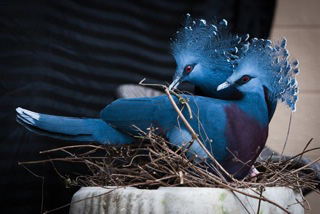 Blue-crowned pigeon |
Michele Raffin: The long-term goal of ARC (Avian Recovery for Conservation) is to prevent selected species from going extinct. We are using tried and true conservation methods. We are able to do this because the US imported 350,000 birds a year from the wild until the Wild Bird Act of 1992 stopped this practice. Therefore, we have a reservoir of birds (and bird keepers) that could be used to re-populate areas that no longer support these birds provided, of course, that there is protected habitat to ensure survival. We do, however, have to act quickly. The birds and the knowledge of how to breed them is vanishing rapidly as both populations are old and won’t be around much longer.
mongabay.com: How can people help your efforts?
Michele Raffin: The most pressing need right now is money. We have all the other pieces in place. We lack funding to move ahead. The very best possible assistance for us would be an endowment. We project that it will cost 12 million dollars to save three very special, amazing species from extinction. Program costs are highest in the first three years since we need to build satellite conservation sites (it’s too dangerous to house a large number of endangered birds in one place. We will spread out the risk by having five geographically remote sites) and we also will be acquiring the birds. As part of the acquisition process, the current breeders of the birds have to agree to teach younger bird keepers. This will be a change to current practices which is that when breeders die, the stock is sold at auction or given away to friends who themselves are old, and the birds are essentially lost. Since none of the breeders write down the information as to how to care for and breed the birds, the knowledge is also lost. ARC will change this when we get the financial backing that we need.
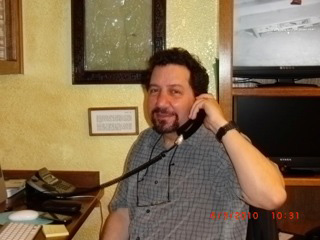 Eric Helfenbein, Pandemonium’s volunteer IT guy 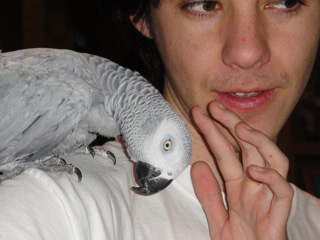 Volunteer Alex with an African Grey |
We already have donated land and bird keepers who want to participate. In addition, we already breed these birds so we have a base of know-how. However, you can’t save a species with just a few birds (well, you can, but the results of in breeding can be disastrous). If we are to be successful, we need to implement the whole program.
While money is at the top of our list of what we need, we continue to need smart and dedicated volunteers in a multitude of disciplines. Our volunteer program is project based. We feel it’s essential that the experience of volunteering be mutually beneficial. Therefore, we want our volunteers to have the work they do for us be work that feeds their soul. We do not have set hours nor do we request a certain number of hours. If they need me to help them identify an interesting project, I do so, but other than that (and to assist if there is a road block), my role is limited. The end result is that many of our volunteers spend a lot of time volunteering. They get caught up in the excitement of doing interesting work and being able to accomplish something meaningful and worthwhile. We had volunteers here every day during the Christmas holidays. I never asked for this. They were responding to the needs of their projects. Some times, volunteers elect to work on a project in which they have no expertise. We actually encourage this. It can lead to problem solving that is innovative, creative and very effective.
On my wish list is support by a printing company and carpentry help. (We never cease to improve our aviaries, in addition to having to change them seasonally.) We also really need new incubators, brooders and an oxygen delivery unit.
mongabay.com: What’s the central message of your work?
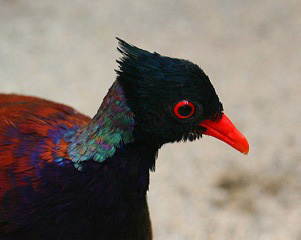 |
Michele Raffin: If there is a take away point from Pandemonium Aviaries, it’s that each one of us can and should contribute to saving some part of the natural world. We each have different talents and capabilities, but I believe that we share a connection to the earth. Some people feel this more strongly than others, but we all have it. This connection, this umbilical cord that roots us to the other life forms which we share the earth, results in each of us being affected by the destruction of nature even if we don’t perceive ourselves as being sympathetic or particularly affected by what is happening. If for no other reason than self-preservation, we each need to do what we can to reverse the damage that is being done. I am particularly sensitive to the needs of those that cannot protect themselves. It has always been extremely painful for me to witness the suffering of others. From the moment that I started to work with focus and dedication on being part of the solution, the despair that I experienced every time I heard a sad news story about still another animal going extinct or a rain forest being torn down, vanished. Now, when a catastrophe like the Gulf oil spill happens, I turn off the news and I re-double my efforts to be of service to, as Henry Beston described animals in the Outermost House: “they are other nations, caught with ourselves in the net of life and time, fellow prisoners of the splendor and travail of the earth.”
Pandemonium Aviaries
Related articles
Sheikh goes from collector to conservationist in effort to save the world’s rarest parrot
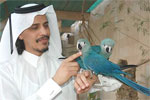
(09/10/2009) Al Wabra Wildlife Preservation (AWWP) is a private conservation and endangered species breeding-center located in the Arabian gulf State of Qatar. Founded by Sheikh Saoud Bin Mohammed Bin Ali Al-Thani, the facility focuses on work with threatened antelope and bird species. Although AWWP has had great success with numerous endangered animals, the Preserve is most noted for developing a captive breeding program for the Spix’s Macaw, a species of parrot now extinct in the wild and once considered “the world’s most endangered bird species.”